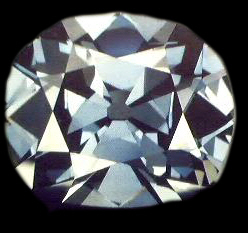




Looking After Your Finds - Reference

Powered By Sispro1
Famous Diamonds


The Taylor Burton Diamond
The Taylor-Burton:
Taylor Burton Diamond - Diamonds have no compassion... "They will be evidence for the wearer if they be able to," says one personality in The Sandcastle, a near the beginning novel by the famed British author, Iris Murdoch. Now this might be true of a few women habitually wearing a disgracefully bulky item of jewelry which show cases a measure of unpleasant offensiveness to themselves - but is it appropriate to Elizabeth Taylor? Those well-showcased gifts which she established from her 5th husband, the belatedly Richard Burton, positively augment her manifestation and do not seem out of place on her. Compatibility is recognized between the jewel and its wearer.
Richard Burton's 1st jewelry procures for Elizabeth Taylor was the 33.19-carat Asscher-cut Krupp Diamond, in 1968. This had previously been part of the estate of Vera Krupp, 2nd wife of the steel magnate Alfred Krupp.
Miss Taylor sports this precious stone in a ring. She has sported it in a number of her post-1968 films, during her conference on CNN's Larry King Live in 2003, and just about all over else she goes. Next the La Peregrina Pearl for which Burton paid 15,000. The stone has an extended and complex history. For the queen's 40th birthday in 1972 Richard Burton presented her a heart-shaped diamond identified as the Taj-Mahal. The stone is practically huge and flat, with an Arabic dedication on each side. It is positioned with rubies and diamonds in a yellow gold rope prototype necklace. "I would have wanted to buy her the Taj-Mahal," he remarked, "but it would charge too much to transfer".
After the death of Elizabeth Taylor in 2012 The diamond was sold at auction.
Taylor Burton Diamond - Diamonds have no compassion... "They will be evidence for the wearer if they be able to," says one personality in The Sandcastle, a near the beginning novel by the famed British author, Iris Murdoch. Now this might be true of a few women habitually wearing a disgracefully bulky item of jewelry which show cases a measure of unpleasant offensiveness to themselves - but is it appropriate to Elizabeth Taylor? Those well-showcased gifts which she established from her 5th husband, the belatedly Richard Burton, positively augment her manifestation and do not seem out of place on her. Compatibility is recognized between the jewel and its wearer.
Richard Burton's 1st jewelry procures for Elizabeth Taylor was the 33.19-carat Asscher-cut Krupp Diamond, in 1968. This had previously been part of the estate of Vera Krupp, 2nd wife of the steel magnate Alfred Krupp.
Miss Taylor sports this precious stone in a ring. She has sported it in a number of her post-1968 films, during her conference on CNN's Larry King Live in 2003, and just about all over else she goes. Next the La Peregrina Pearl for which Burton paid 15,000. The stone has an extended and complex history. For the queen's 40th birthday in 1972 Richard Burton presented her a heart-shaped diamond identified as the Taj-Mahal. The stone is practically huge and flat, with an Arabic dedication on each side. It is positioned with rubies and diamonds in a yellow gold rope prototype necklace. "I would have wanted to buy her the Taj-Mahal," he remarked, "but it would charge too much to transfer".
After the death of Elizabeth Taylor in 2012 The diamond was sold at auction.

The Hope diamond
The Hope Diamond is a large, deep blue diamond which weighs 45.5 carats. The diamond was found in India in the Goloconda area as a rough crystal weighing 112 carats. The Hope diamond appears blue because of traces of boron within the diamond.
Jean Baptiste Travernier purchased the diamond in India and sold the diamond to King Louis XIV of France in 1668. The court jeweller cut the diamond and produced a 67 carat gem. The diamond was then called Blue Diamond of the Crown, French Blue or Travernier Blue and King Louis wore the diamond on a pendant around his neck on ceremonial occasions.
During the French Revolution the necklace with the diamond pendant was stolen and brought to London. Then the diamond disappeared.
Later in 1824 a blue diamond was recorded in the possession of Henry Phillip Hope. This diamond was believed to have been cut from the French Blue and is now called the Hope diamond or Blue Hope.
After Hope s death the diamond was owned by many people, including the nephew of Hope, Henry Hope, his wife Adele, the jewel merchant Adolf Weil, the diamond merchant Pierre Cartier, the New York diamond merchant Harry Winston who finally donated the Hope diamond to the Smithsonian Institution in 1958 where the diamond is still today.
Legends around the Hope diamond
The diamond is said to bring misfortune to its possessors, because it is believed to be stolen from an eye of a Hindu idol of the goddess Sita in India. And indeed many who possessed the Hope diamond died young or went bankrupt or were killed
The Hope Diamond is a large, deep blue diamond which weighs 45.5 carats. The diamond was found in India in the Goloconda area as a rough crystal weighing 112 carats. The Hope diamond appears blue because of traces of boron within the diamond.
Jean Baptiste Travernier purchased the diamond in India and sold the diamond to King Louis XIV of France in 1668. The court jeweller cut the diamond and produced a 67 carat gem. The diamond was then called Blue Diamond of the Crown, French Blue or Travernier Blue and King Louis wore the diamond on a pendant around his neck on ceremonial occasions.
During the French Revolution the necklace with the diamond pendant was stolen and brought to London. Then the diamond disappeared.
Later in 1824 a blue diamond was recorded in the possession of Henry Phillip Hope. This diamond was believed to have been cut from the French Blue and is now called the Hope diamond or Blue Hope.
After Hope s death the diamond was owned by many people, including the nephew of Hope, Henry Hope, his wife Adele, the jewel merchant Adolf Weil, the diamond merchant Pierre Cartier, the New York diamond merchant Harry Winston who finally donated the Hope diamond to the Smithsonian Institution in 1958 where the diamond is still today.
Legends around the Hope diamond
The diamond is said to bring misfortune to its possessors, because it is believed to be stolen from an eye of a Hindu idol of the goddess Sita in India. And indeed many who possessed the Hope diamond died young or went bankrupt or were killed
The Hope Diamond
Copyright All Rights Reserved by Nigel G Wilcox E-Mail: ngwilcox100@gmail.com
Rocks & Minerals Menu
Complimentary Topics
Designed by Nigel G Wilcox
The Paragon Of Metal Detecting
& Archaeology
& Archaeology
Who Owns the World's Gold?
Pages
Member NCMD
Reference Menu
Group Pages
[1]
[2]
[3]
[4]
[5]
[6]
[7]
[8]
Famous Diamonds




















